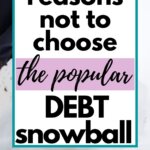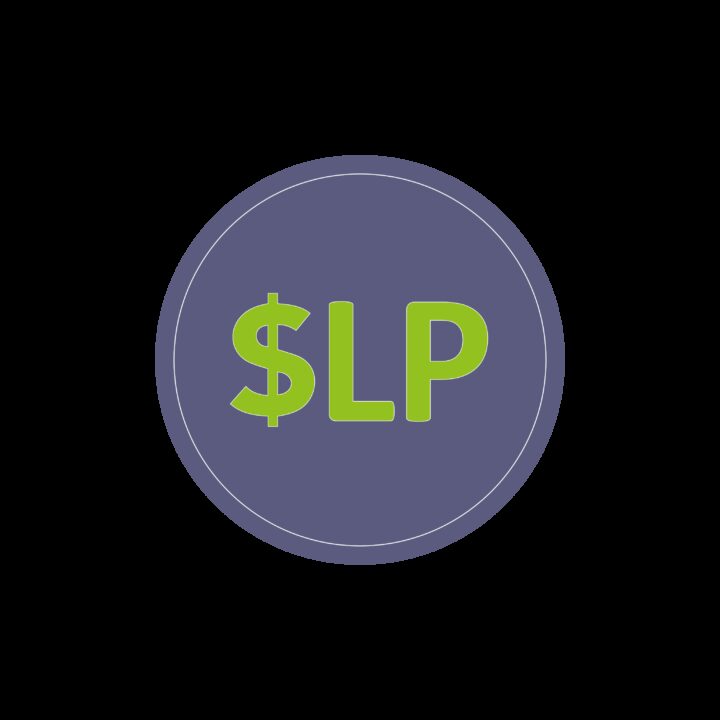5 Reasons NOT to Choose the Popular Debt Snowball Method
This post may contain affiliate links, which helps us to continue providing relevant content and we receive a small commission at no cost to you. As an Amazon Associate, I earn from qualifying purchases. Please read the full disclosure here.
Debt snowball method is a wildly popular way to pay off debt.
It has helped millions of people pay off their debt, which is great. However, it may not be the best method to actually pay off debt in the end.
Wait…
Isn’t the debt snowball the only way to pay off debt? That is what Dave Ramsey teaches everyone to do, right?
There may be other methods – debt avalanche or debt stacking, debt snowflake, or a combination of all the methods that work the best.
So, should you choose the popular debt snowball method?
If you are thinking, I have no idea what all of the terms mean. Don’t worry… we will uncover all of the terms, so you can make a logical choice for you.
Today, we are going to dig into whether or not the debt snowball will work best for you.
Remember, this is your journey to becoming to debt free. So, be wary of comparing you situation to others. It will always be vastly different.

How the Debt Snowball Works
Before we dig into the reasons against the debt snowball method, first let’s find common ground on how the debt snowball works.
First of all, throw out the interest rates on all of your debts as well as the payment amount. With the debt snowball, none of these factors are considered. They don’t matter when using this method to pay off debt.
Now, how to the debt snowball works…
- List out all of your debt smallest to largest.
- That is the order you will pay off your debt.
- Once the smallest debt is paid off, you snowball it to the next debt. (You pay whatever you paid on the first debt and move that amount to the next debt.)
- Then, you continue the debt snowball until all debts are paid off.
In a quick nutshell, that is how the debt snowball works.
No considering any other factors to your personal finance situation or outside influences such as interest rates.
How do I Calculate my Snowball Debt?

1. Grab one of our free debt snowball printables from our resource library.
2. Write down all of your debts. The order doesn’t matter at this point. You will order them shortly.
3. Now, list of all of your debts in order by the total amount of debt from smallest amount to largest amount.
Remember with the debt snowball, you start by paying off your smallest debt first and keep “snowballing” the money to your next debt.
4. Work on paying off your first debt. Once that debt is paid off, then snowball the money to your next debt on the list.
5. Keep repeating the process until all of your debts are paid off.
Bonus Tip: Use one of the best debt apps to help you. These debt snowball calculators are much quicker and can take much of the guess work out for you.
Does the Debt Snowball Work?

Yes, the debt snowball method really works, but it may not be the best choice on how to pay off your debt.
There is one part of the debt snowball technique that is crucial and needs to be remembered. This is the key part of how the debt snowball method works that should be carried over to any method you use to pay off debt.
One of the debt snowball rules is to continue rolling extra money to the next debt when the first debt is paid off.
That is the part of the debt snowball that works regardless of the debt payoff method.
Just because you paid off one debt that doesn’t mean you have less going to debt every month.
In fact, the amount going to debt is the same each month.
You are snowballing extra money to pay off the remaining debts faster.
Debt Snowball Example

Throughout the post, we will use two examples as a case study. That way you can see the positive and negatives for your own situation. The reason we will explain two situations is because not every debt and personal life is the same, so the examples need to be varied as well.
Also, it is easier to plead one side of the story when only using one set of variables. Thus, we will use two examples.
Debt Snowball Example #1:
Joe and Susie have accumulated $115,000 of debt. They are ready to pay off their debt and move on with life. Their debts include:
- Student Loans: $35,000 at 3.25% interest rate with a $312 payment
- Credit Card #1: $24,000 at 23.5% interest rate with a $440 payment
- Credit Card #2: $19,000 at 18% interest rate with a $380 payment
- Store Credit Card #3: $6,000 at 21% interest rate with a $240 payment
- Car Loan #1: $21,000 at 6% interest rate with a $445 payment
- Car Loan #2: $10,000 at 5.25% interest rate with a $200 payment
Debt Snowball Method:
- Debt Free Date: March 2027
- Total Interest Paid: $57,560
Debt Avalanche Method:
- Debt Free Date: February 2027
- Total Interest Paid: $54,365
**If you add additional debt payments, the difference in pay off date and total interest paid grows.
Debt Snowball Example #2:
Mary has accumulated $38,000 of debt. She finally feels like she can be successful in paying off debt this time, but wants to make sure she does with without any setbacks. Her debts include:
- Student Loans: $5,000 at 3.25% interest rate with a $100 payment
- Credit Card #1: $18,000 at 17.5% interest rate with a $360 payment
- Credit Card #2: $3,000 at 23.5% interest rate with a $60 payment
- Car Loan #1: $12,000 at 6% interest rate with a $232 payment
Debt Snowball Method:
- Debt Free Date: Nov 2021
- Total Interest Paid: $5,146
Debt Avalanche Method:
- Debt Free Date: Oct 2021
- Total Interest Paid: $3,499
**If you add additional debt payments, the difference in pay off date and total interest paid grows.

Reasons Against the Debt Snowball Method
It is hard to predict the future. You can’t look into a magical glass and see the future. Case in point of the year 2020. That situation highlights the reason I don’t like the debt snowball as a method to pay off debt for good.
While the momentum to pay off debt is good and well, it may not have your best interests in mind during the long term.
Here are serious points to consider when you are paying off your debt.
1. Pay More Interest
In the end, the likelihood of paying more money in interest payments is increased.
Since the debt snowball does not take into account the interest rate on any of the accounts, you can end up paying much more money.
Debt Snowball Example #1:
In the first example, Joe and Susie would pay $2396 if they followed the debt snowball method. Given this is a relatively low number compared to their total debt.
Debt Snowball Example #2:
Mary would pay substantially less by not following the debt snowball method. She would save $1647.
Given that Mary’s debt is much less than Joe and Susie’s debt, the amount of interest she can save is substantial. That is one easy way to lower the overall effective interest rate.
2. Debt Snowball Fatigue
Let’s face it… The last debt is the debt with the largest balance and will take the longest to pay off. I know many people will say… You are snowballing (adding) the other debt payments to the biggest balance at the end.
However, the biggest balance will take the longest to pay off regardless.
That is when debt snowball fatigue sets in.
You become sick and tired of trying to pay off debt. That is the point many people give up and go back to their old habits.
Debt snowball fatigue is a real thing! It becomes harder and harder to find debt payoff motivation.
Debt Snowball Example #1:
For Joe and Susie, half of their debts hover around the $20K mark yet have substantially different interest rates.
Their second to highest debt is always their highest interest rate. Meaning they would have to pay off $56,000 before they are able to tackle their highest interest rate. If you hit debt snowball fatigue, then you might end up paying a whole lot more.
Regardless of the method chosen, their student loan debt would be the last to be paid off since it is the highest debt and lowest interest rate.
Debt Snowball Example #2:
For Mary, she would pay off all of high interest debt last. That means she would have to stay focused throughout the steps.
In order to overcome this fatigue, you must stay motivated. Use mini-milestones along the way to help you.
3. Financial or Personal Crisis

This is the main reason I advise against the debt snowball method. You don’t have a crystal ball to see into the future. You have no idea what unexpected things that can arise.
Specifically, you have no idea how a financial or personal crisis can delay or pause your debt payoff.
When it does, you are left to pay off the biggest balance debt, which also might be the highest interest rate, too. In order to handle the crisis, you are back to paying the minimum debt payments, then more of your hard earned money is going to interest and not paying down the actual debt.
So, what then? Your debt snowball has blown up to a debt mess.
Related Reading: 10 Money Management Tips in Crisis Times to Help You Stay Afloat
In these examples, we are going to assume a crisis is going to hit halfway through paying off your debt.
Debt Snowball Example #1:
For Joe and Susie, they would have the following debts still to pay with the debt snowball method:
- Credit Card #1: $24,000 – they would be at the very beginning of this debt @ 23.5% interest rate
- Student Loans: $35,000 at 3.25% interest rate
During their crisis, they would rack up significant amount of credit card interest when using the debt snowball method.
Debt Snowball Example #2:
Mary would be in a tough spot with her highest credit card amount left. For her, this is probably where she would give up and continue to accumulate more credit card debt.
- Car Loan #1: $1000 left of her $12K loan at 6% interest rate
- Credit Card #1: $18,000 at 17.5% interest rate with a $360 payment
4. Debt is Snowballed Back

This fact makes me so sad. After working years to pay off debt, people find themselves right back into debt.
For those who aren’t back in debt yet, they haven’t made much progress with their personal finances either.
The ultimate reason why is they haven’t changed their money mindset.
Maybe for a short season, you worked hard to pay off debt only to let one thing slip and then find the debt snowball of bills racking up.
It is the whole process in reverse. Debt is snowballed back and they are now once again a slave to the debt.
I truly wish it wasn’t true. But, it is. And those who find themselves in this situation are terrified to say anything.
Must Read: With the Right Money Mindset, Go from Broke to Rich
5. End Goal is Pay Off Debt
You must be wondering… Isn’t the end goal to pay off debt?
Why yes! Of course!
Get out of debt is the key reason to make sacrifices in order to pay off debt faster.
However, that shouldn’t be the end goal on your money journey.
There is so much more to uncover along the way to financial freedom that should you stop at just paying off debt?
What to you think? (don’t worry the answer is coming)
Paying off debt is one step in the right direction of making a strong foundation with money. However, it is far the last step!
What are your money goals?
Paying off debt is the step in the right direction, just make sure, when you are done that you have something else you are working towards.
Note on Dave Ramsey Debt Snowball…

Over the years, Dave Ramsey is the person who has made the debt snowball so wildly successful. Given that fact, he has propelled millions of people to pay off debt is to be commended. In no way, shape, or form is this an attack on Dave Ramsey snowball method.
The key part of the debt snowball that works regardless in how to get out of debt is rolling the debt payment from one payment to the next.
You don’t need to the debt snowball to do that. All you need is perseverance to continue paying off debt with all of the money allocated towards debt.
Will You Choose the Debt Snowball Method?

There are pros and cons to any decision.
Paying off your debt is the key! That moment will be the catalyst for the next step in your financial journey.
Now, that we have gone over everything you need to know about the debt snowball method and the reasons to consider a different method, I will tell you our decision for how we paid off debt…
Do you have any idea what method we used to pay off debt?
Just for reference… we successfully paid of $53,000 of debt within one year. It was the first and only attempt to pay off our debt quickly.
So, you will have to learn how we paid off debt by clicking the link.
Now, that you are equipped with knowledge… will you choose the debt snowball method?
Creative Ways to Pay Off Debt Faster
Let's face it... Money is tight when you are paying off debt. Yet, every dollar helps you reach your goals.
Here are the most creative ways to pay off your debt and then you can begin to save more money.
Invest with Teri - Make $1000 a day
Learn how to supplement your daily, weekly, or monthly income with trading so that you can pay off debt and change your financial future! This is a lifestyle trading style you need to learn.
Honestly, this course is a must for anyone who invests. You will lose more in the market than you will spend this quality education - guaranteed.
Six-Figure Debt to Six-Figure Net Worth
Learn how to reach a six figure net worth in 5 to 10 years, even if you have a massive amount of student loans.
This beginning investment course will help you pay off debt and start your path to six figures.
Stop the Student Loan Debt with Scholarship System
Before you go thousands of dollars into student loan debt, use this proven system to find scholarships and grants.
A little work today will pay off in the long run.
No starting your life with a negative net worth.
LendKey - Student Loan Refinancing
If you haven't consolidated and refinanced your loans, then this needs to be on your monthly to-do list.
Shop from a network of not-for profit, local lenders who offer low-cost and low-rate student loan refinancing. Start your application today to find the best interest rates.
Free Online Debt Snowball/Avalanche Calculator | Undebt.it
This is a free app that will help you to pay off your debt faster.
Sign up today and learn to live debt free.
Tally: Pay Off Debt Faster
Tally is the world’s first automated debt manager that makes it easy to save money, manage your cards and pay down balances faster.
Make sure to activate your account within the first 7 days.

Did the post resonate with you?
More importantly, did I answer the questions you have about this topic? Let me know in the comments if I can help in some other way!
Your comments are not just welcomed; they’re an integral part of our community. Let’s continue the conversation and explore how these ideas align with your journey towards Money Bliss.










